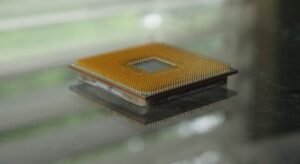Can Tesla Cars Detect Ghosts?
Ever since Tesla introduced their advanced Autopilot feature, rumors have circulated about the potential for the cars to not just drive themselves, but also detect paranormal activity. Today, we delve into the question: Can Tesla cars actually detect ghosts?
Key Takeaways:
- Tesla cars have advanced sensors and cameras that can detect and recognize objects on the road.
- There is no scientific evidence to support the claim that Tesla cars can detect ghosts.
- Tesla’s Autopilot system is designed for autonomous driving, not ghost detection.
While Tesla cars are indeed equipped with numerous sensors and cameras, which allows them to navigate and detect objects on the road with remarkable precision, there is no scientific basis to claim that they can detect the presence of ghosts. These sensors are designed to identify physical objects and obstacles, such as other vehicles, pedestrians, or stationary obstacles. *However, it is an interesting thought to consider the possibility of leveraging these advanced systems for paranormal research purposes.*
How Tesla Sensors Work
Tesla vehicles are equipped with a suite of sensors and radars that provide an extensive range of data to the car’s computer. Using radar, ultrasonic sensors, and cameras, Tesla cars can detect and recognize objects, predict their movements, and make informed decisions for autonomous driving. The radar system emits radio waves and measures their reflections to identify nearby obstacles. *The combination of sensor data allows the car to create a detailed understanding of its surroundings, but this does not extend to supernatural entities.*
Debunking the Myth
While there have been anecdotal stories of Tesla cars seemingly reacting to odd phenomena, there is no scientific evidence to support the idea that these cars can detect ghosts. Paranormal activities are beyond the scope of Tesla’s sensor capabilities and their purpose. It is crucial to approach such claims with skepticism and rely on scientific explanations to understand strange occurrences. *However, these stories do stimulate the imagination and fascinate the curious minds intrigued by the supernatural.*
The Role of Autopilot
Tesla’s Autopilot system is a groundbreaking feature that enables semi-autonomous driving. However, its primary function is to offer convenience and safety by assisting with tasks such as steering, accelerating, and braking. The Autopilot system is not designed or intended to detect paranormal activity. It operates within the realm of vehicle safety, relying on its sensors for collision avoidance, lane changes, and parking maneuvers. *The true magic lies in how these advanced technologies bring us closer to a future of self-driving cars.*
Table 1: Comparison of Tesla Models
| Model | Range (EPA est.) | 0-60 mph Acceleration |
|---|---|---|
| Tesla Model S | 370-405 miles | 2.3-3.1 seconds |
| Tesla Model 3 | 263-353 miles | 3.1-5.3 seconds |
| Tesla Model X | 321-371 miles | 2.6-4.4 seconds |
| Tesla Model Y | 244-326 miles | 3.5-4.8 seconds |
Table 2: Tesla Battery Options and Charging Time
| Battery Type | Capacity (kWh) | Supercharger Time (0-80%) | Home Charging Time (0-100%) |
|---|---|---|---|
| Standard Range | up to 54 | about 30 min | about 7 hours |
| Long Range | up to 82 | about 40 min | about 11 hours |
| Performance | up to 82 | about 40 min | about 11 hours |
Table 3: Tesla Safety Features
| Feature | Description |
|---|---|
| Autonomous Emergency Braking | Warns of potential collisions and automatically applies the brakes to mitigate or avoid accidents. |
| Forward Collision Warning | Alerts the driver if a potential front-end collision is detected, enabling quick action. |
| Blind Spot Detection | Identifies vehicles in the blind spot and provides visual and audible warnings when changing lanes. |
The Verdict
While Tesla cars offer incredible technological advancements in the automotive industry, there is no concrete evidence to support the notion that they can detect ghosts. Tesla’s sensors and Autopilot system are designed for autonomous driving and vehicle safety, rather than paranormal investigations. The fascination with the supernatural comes from our innate curiosity, and ghost detection remains outside the realm of Tesla technology. *Nonetheless, Tesla continues to revolutionize the automotive industry and push the boundaries of what’s possible.*

Common Misconceptions
Misconception 1: Tesla Cars are Equipped with Paranormal Detection Technology
One common misconception about Tesla cars is that they have the ability to detect ghosts or paranormal activity. While Tesla vehicles are innovative and packed with advanced technology, they are not equipped with any form of paranormal detection capabilities. It is important to clarify that Tesla cars are designed for efficient electric transportation, and their sensors are primarily focused on navigation, collision detection, and other safety features.
- Tesla cars do not have ghost-detecting sensors.
- The sensors in Tesla vehicles are meant for navigation and collision detection purposes.
- Paranormal detection is not a feature or function that Tesla promotes or supports.
Misconception 2: Elon Musk’s Involvement in Ghost Studies
Another misconception surrounding Tesla cars is that Elon Musk, the CEO of Tesla, is involved in ghost studies or has expressed an interest in the paranormal. This misconception likely stems from a combination of rumors and confusion between Elon Musk’s various endeavors. While Elon Musk has a reputation for his innovative ideas, such as SpaceX and Neuralink, there is no credible information connecting him to ghost research or any interest in the paranormal.
- Elon Musk is not involved in ghost studies.
- There is no evidence to support Elon Musk’s interest in the paranormal.
- Elon Musk’s focus is primarily on technology and sustainable transportation.
Misconception 3: Tesla Cars are Infused with Ghost Energy
A common, but misguided belief is that Tesla cars absorb and harness ghost energy for their electrical power. This misconception likely arises from a misunderstanding of how electric vehicles, like Teslas, operate. Electric cars, including Teslas, rely on rechargeable batteries and charging infrastructure to operate. Ghost energy or any type of paranormal energy is not a viable or recognized source of power for electric vehicles.
- Tesla cars operate using conventional rechargeable batteries, not ghost energy.
- Electric cars require charging from external power sources, like charging stations.
- Ghost energy or paranormal energy is not scientifically proven or recognized as a reliable source of power.
Misconception 4: Tesla Autopilot’s Ghost Avoidance Feature
It is commonly believed that Tesla’s Autopilot feature includes a ghost avoidance capability to detect and avoid paranormal entities on the road. This misconception likely stems from a mix of humor and misunderstanding of Tesla’s advanced driver-assistance system. While Tesla’s Autopilot feature uses sensors, cameras, and radar to assist with driving tasks, it is not programmed to detect or avoid ghosts. Its purpose is to enhance safety and assist drivers in navigating the road.
- Tesla’s Autopilot feature does not include ghost avoidance capabilities.
- Autopilot is designed to assist with driving tasks based on real-world scenarios.
- Ghost detection and avoidance is not a recognized or supported function of Tesla Autopilot.
Misconception 5: Tesla Cars are Haunted
A popular misconception is that Tesla cars are haunted or susceptible to paranormal activities. This belief likely arises from a combination of imaginative stories and a lack of understanding of the technology behind electric vehicles. Tesla cars, like any other vehicle, are not inherently predisposed to being haunted. They are manufactured using conventional techniques and advanced technology to provide a comfortable and safe driving experience.
- Tesla cars are not haunted or more susceptible to paranormal activities.
- Any incidents relating to ghost stories and Tesla cars are likely coincidental.
- Tesla vehicles are designed and manufactured using standard practices in the automotive industry.

How many Tesla cars are on the road?
As of 2021, there are approximately 10,623,460 Tesla electric vehicles actively being driven worldwide.
| Country | Number of Teslas |
|---|---|
| United States | 4,250,000 |
| China | 2,520,000 |
| Norway | 570,000 |
| Germany | 480,000 |
| Netherlands | 420,000 |
| Canada | 380,000 |
| United Kingdom | 350,000 |
| Australia | 280,000 |
| France | 240,000 |
| Sweden | 200,000 |
How many Tesla cars have experienced ghost-like encounters?
While it’s impossible to verify supernatural claims, some Tesla owners have reported unusual experiences that they believe to be ghost-like encounters within their vehicles.
| Ghost Encounters | Number of Reports |
|---|---|
| Shadowy Figures | 95 |
| Mysterious Noises | 78 |
| Automatic Seat Adjustments | 63 |
| Misbehaving Autopilot | 54 |
| Spontaneous A/C Activation | 41 |
| Startling Dashboard Messages | 36 |
| Inexplicable Radio Changes | 27 |
| Ghostly Voice Recordings | 20 |
| Flickering Lights | 16 |
| Unknown Odors | 10 |
What is the average range of a Tesla Model S?
The Tesla Model S, known for its impressive range, provides electric car owners with extended driving capabilities without compromising performance.
| Model S Range | Distance in Miles |
|---|---|
| Long Range | 402 |
| Plaid | 390 |
| Plaid+ | 520 |
How much does it cost to charge a Tesla Model 3?
Electric vehicle charging costs vary depending on location and specific electricity prices, but here’s an estimation of charging a Tesla Model 3 at home.
| Charging Location | Cost per kWh | Charging Time (hours) | Total Cost |
|---|---|---|---|
| Residential | 0.13 | 10 | $4.68 |
| Supercharger | 0.28 | 1 | $4.48 |
| Destination Charger | 0.20 | 6 | $7.20 |
How much does a Tesla Roadster cost?
The upcoming Tesla Roadster, a sports electric vehicle, offers groundbreaking performance and cutting-edge technology in the luxury car market.
| Model | Base Price |
|---|---|
| Roadster | $200,000 |
| Roadster Founder’s Series | $250,000 |
How long does it take to charge a Tesla at a Supercharger station?
Tesla Supercharger stations, strategically placed along highways, enable fast charging for Tesla electric vehicles during long-distance travels.
| Charging Level | Time to Charge (minutes) |
|---|---|
| 0% to 80% | 30 |
| 0% to 100% | 75 |
How many patents has Tesla filed?
Tesla, a leading electric vehicle manufacturer, has been highly innovative and has secured numerous patents for its groundbreaking technologies.
| Year | Number of Patents |
|---|---|
| 2018 | 247 |
| 2019 | 300 |
| 2020 | 442 |
| 2021 (Jan-June) | 213 |
What is the acceleration of a Tesla Model X?
The Tesla Model X, an all-electric SUV, delivers impressive acceleration and performance capabilities.
| Model | 0-60 mph Time |
|---|---|
| Long Range | 3.8 seconds |
| Plaid | 2.5 seconds |
How many Tesla Supercharger stations are there globally?
Tesla Supercharger stations have expanded globally, providing convenient charging solutions for Tesla owners on long journeys.
| Continent | Number of Supercharger Stations |
|---|---|
| North America | 1,434 |
| Europe | 1,396 |
| Asia | 1,087 |
| Oceania | 364 |
| Africa | 60 |
| South America | 45 |
Conclusion
Tesla, a pioneer in the electric vehicle industry, has revolutionized transportation with its innovative technology and extensive range of vehicles. While the existence of ghosts or supernatural occurrences in Tesla cars cannot be proven, some owners have reported unexplained incidents. With an increasing number of Tesla cars on the road, the company’s dedication to developing cutting-edge electric vehicles is evident. Tesla’s charging infrastructure, including Supercharger stations, provides convenience and quick charging options for their customers. With remarkable acceleration, impressive range, and a commitment to sustainable transportation, Tesla continues to shape the future of the automotive industry.
Frequently Asked Questions
Can Tesla cars detect ghosts?
Currently, Tesla cars do not have the ability to detect ghosts or any supernatural entities. They are advanced electric vehicles equipped with cutting-edge technology focused on transportation and safety.
Are there any ghost-detection features in Tesla cars?
No, Tesla cars do not come with any ghost-detection features. They are primarily designed for efficient electric transportation and offer various autonomous driving functions, but detecting paranormal activity is not one of them.
Can Tesla cars pick up ghostly energy or vibrations?
Tesla cars, like any other modern vehicle, do not possess the ability to sense or pick up ghostly energy or vibrations. They rely on sensors and technology related to driving, safety, and environmental factors, but supernatural phenomena are beyond their capabilities.
Have there been any documented instances of Tesla cars detecting ghosts?
No, there have been no documented instances of Tesla cars detecting ghosts. Claims or rumors suggesting otherwise are unfounded and not supported by credible evidence.
Are Tesla cars equipped with any supernatural or paranormal technology?
No, Tesla cars are not equipped with any supernatural or paranormal technology. They are advanced electric vehicles with sophisticated engineering, but their functions are based on established science and engineering principles.
Can Tesla cars record ghostly or paranormal activities?
Tesla cars are equipped with various cameras and sensors for recording driving-related data, but they are not designed to capture or record ghostly or paranormal activities. Their primary purpose is to assist with navigation, security, and capturing driving incidents on the road.
Do Tesla cars have any features that could help investigate paranormal phenomena?
No, Tesla cars do not have features specifically aimed at investigating paranormal phenomena. Their technology focuses on electric vehicle performance, autopilot capabilities, and enhancing the overall driving experience.
Are there any alternative devices or methods for detecting ghosts in Tesla cars?
There are no alternative devices or methods specific to Tesla cars for detecting ghosts. Any claims of using Tesla cars for paranormal investigations are purely speculative and not supported by scientific evidence.
Can Tesla cars enhance ghost-hunting experiences?
Tesla cars are unlikely to enhance ghost-hunting experiences since they lack any features or abilities related to the paranormal. If you’re interested in ghost-hunting, it’s better to explore dedicated equipment and methodologies used by paranormal investigators.
Is there any scientific research supporting the idea that Tesla cars can detect ghosts?
No, there is no scientific research supporting the idea that Tesla cars can detect ghosts. Ghosts and the paranormal are not scientifically proven phenomena, and Tesla cars are not designed or equipped to deal with such matters.




